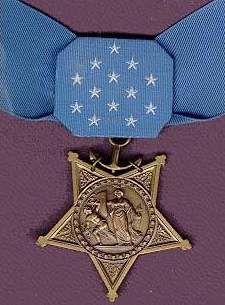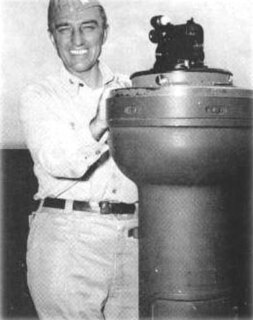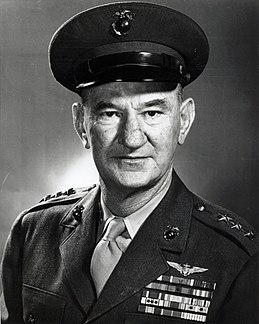Related Research Articles

Frank Wilbur "Spig" Wead was a U.S. Navy aviator who helped promote United States Naval aviation from its inception through World War II. Commander Wead was a recognized authority on early aviation. Following a crippling spinal injury in 1926, Wead was placed on the retired list. In the 1930s, he became a screenwriter, becoming involved in more than 30 movies. He also published several books, short stories and magazine articles. During World War II, he returned to active duty. He initially worked in a planning role, but later undertook sea duty in the Pacific, where he saw action against the Japanese in 1943–44 before being placed on the retired list in mid-1945.

Bruce Avery Van Voorhis was a United States Navy aviator who was shot down in the Pacific theater during World War II. For his action on July 6, 1943, he was posthumously awarded the Medal of Honor.

Winfield Scott Cunningham was the Officer in Charge, Naval Activities, Wake Island when the tiny island was attacked by the Japanese on December 8, 1941. Cunningham commanded the defense of the island against the massive Japanese attack. After 15 days, he surrendered the island to the Japanese. Cunningham was taken prisoner and held as a POW in Japan. He was awarded the Navy Cross for his leadership at Wake Island.

Thomas Lamison Sprague was a vice admiral of the United States Navy, who served during World War II as commander of the aircraft carrier Intrepid and took part in the battles of Guam, Leyte Gulf and Okinawa.
Apollo Soucek was a vice admiral in the United States Navy, who was a record-breaking test pilot during 1929-1930, served in World War II, and was commander of Carrier Division Three during the Korean War, ending his career as Chief of the Bureau of Aeronautics.

William Oscar Brice, CBE was a United States Marine Corps General and a veteran of the Korean War, the World War II fight for the Solomon Islands and pre-war expeditionary duty in Haiti and China. He last served at Pearl Harbor as commanding general, Fleet Marine Force, Pacific, after more than three years at Headquarters Marine Corps, Washington, D.C., as Director of Aviation.

Major Floyd Bruce "Red" Parks was a decorated aviation officer in the United States Marine Corps during World War II.
William Bowen Ault was a commander in the United States Navy during World War II and a posthumous recipient of the Navy Cross.

Jack Mason Gougar was a full career aviator with the United States Navy. Beginning his career as an enlisted man, he earned his commission as a Mustang while participating in World War II.
Edwin William Hurst was born October 16, 1910 at Falls City, Nebraska.

Patrick Nieson Lynch Bellinger was a highly decorated officer in the United States Navy with the rank of Vice Admiral. A Naval Aviator#8 and a naval aviation pioneer, he participated in the Trans-Atlantic flight from Newfoundland to Azores in May 1919 and was decorated with Navy Cross, the United States military's second-highest decoration awarded for valor.

Albert William Tweedy Jr., a United States Marine Corps aviator, was awarded the Navy Cross for his actions in the Battle of Midway during World War II. The USS Tweedy was named in his honor.

Jackson Dominick Arnold was a four-star admiral in the United States Navy who served as Chief of Naval Material (CNM) from 1970 to 1971.

Frederick T. Moore Jr. was a United States Navy captain. During World War II, he was executive officer of Fighter Squadron 1 operating off the carrier USS Yorktown (CV-10) and commanding officer of the Air Group 35 aboard the aircraft carrier USS Chenango in the Pacific. During the Korean War, he was the commanding officer of naval air training at NAS Pensacola and the air officer on USS Coral Sea. His first sea command was aboard USS Suribachi. In 1962–1963, Moore was the eighth commanding officer of USS Saratoga. Late in his career during the Vietnam War, he was Chief of Staff of the Naval Air Training Command at Naval Air Station Pensacola from October 1965 to July 1969.

William Virginius Davis Jr. was a vice admiral in the United States Navy.

Jesse Junior Taylor was a United States Navy naval aviator, Lieutenant Commander during the Vietnam War. He also served as an enlisted man during World War II. He was posthumously awarded the Navy Cross for actions 17 November 1965 over North Vietnam. He was the namesake of USS Taylor.

Lance Edward "Lem" Massey was a U.S. Navy pilot during World War II.
Charles Perry Mason was an American Vice Admiral of the United States Navy and an early naval aviator. He was the Mayor of Pensacola from 1947 to 1957 and again from 1963 to 1965.

Frank Dechant Wagner was a highly decorated Naval aviator in the United States Navy with the rank of Vice Admiral. A Naval Academy gradute, Wagner distinguished himself as Commander of Patrol Wing Ten during operations against the enemy in the early weeks of the Japanese Invasion of the Philippines. He was then promoted to the general officer's rank and served as Commander, Aircraft, Seventh Fleet during liberation of the Philippines in 1944-1945.
Theodore Hugh Winters Jr. was a highly decorated United States Navy captain. He was a flying ace credited with eight aerial victories and was awarded two Navy Crosses during the battle of Leyte Gulf in World War II.
References
- This article incorporates text from the public domain Dictionary of American Naval Fighting Ships .The entry can be found here.